fuel type VAUXHALL ZAFIRA TOURER 2014 Owner's Manual
[x] Cancel search | Manufacturer: VAUXHALL, Model Year: 2014, Model line: ZAFIRA TOURER, Model: VAUXHALL ZAFIRA TOURER 2014Pages: 297, PDF Size: 8.87 MB
Page 23 of 297
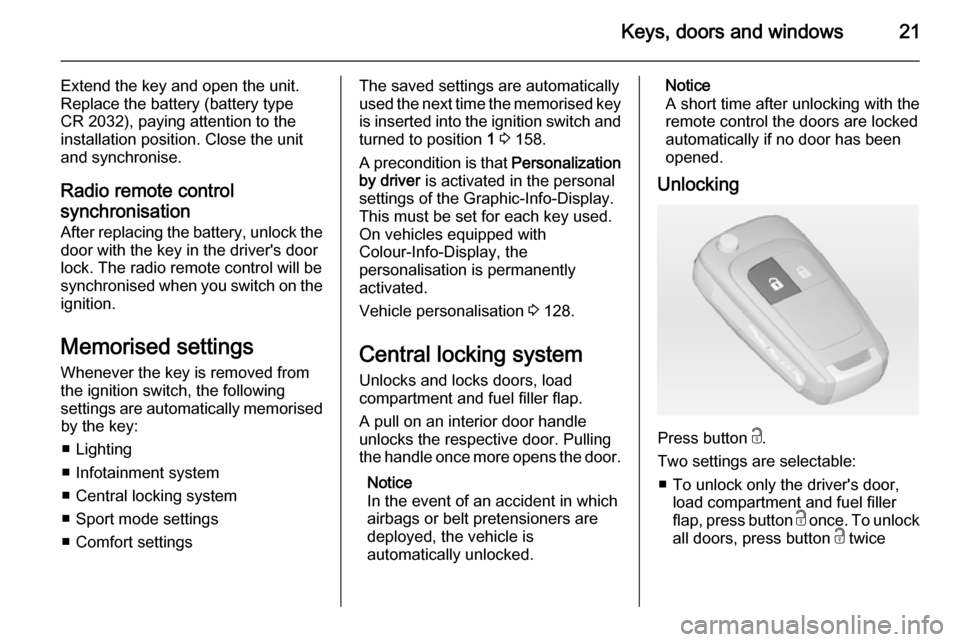
Keys, doors and windows21
Extend the key and open the unit.
Replace the battery (battery type
CR 2032), paying attention to the installation position. Close the unit
and synchronise.
Radio remote control
synchronisation
After replacing the battery, unlock the
door with the key in the driver's door
lock. The radio remote control will be
synchronised when you switch on the
ignition.
Memorised settings Whenever the key is removed from
the ignition switch, the following
settings are automatically memorised by the key:
■ Lighting
■ Infotainment system
■ Central locking system
■ Sport mode settings
■ Comfort settingsThe saved settings are automatically
used the next time the memorised key
is inserted into the ignition switch and
turned to position 1 3 158.
A precondition is that Personalization
by driver is activated in the personal
settings of the Graphic-Info-Display.
This must be set for each key used.
On vehicles equipped with
Colour-Info-Display, the
personalisation is permanently
activated.
Vehicle personalisation 3 128.
Central locking system Unlocks and locks doors, load
compartment and fuel filler flap.
A pull on an interior door handle
unlocks the respective door. Pulling the handle once more opens the door.
Notice
In the event of an accident in which
airbags or belt pretensioners are
deployed, the vehicle is
automatically unlocked.Notice
A short time after unlocking with the
remote control the doors are locked
automatically if no door has been
opened.
Unlocking
Press button c.
Two settings are selectable: ■ To unlock only the driver's door, load compartment and fuel filler
flap, press button c once. To unlock
all doors, press button c twice
Page 106 of 297
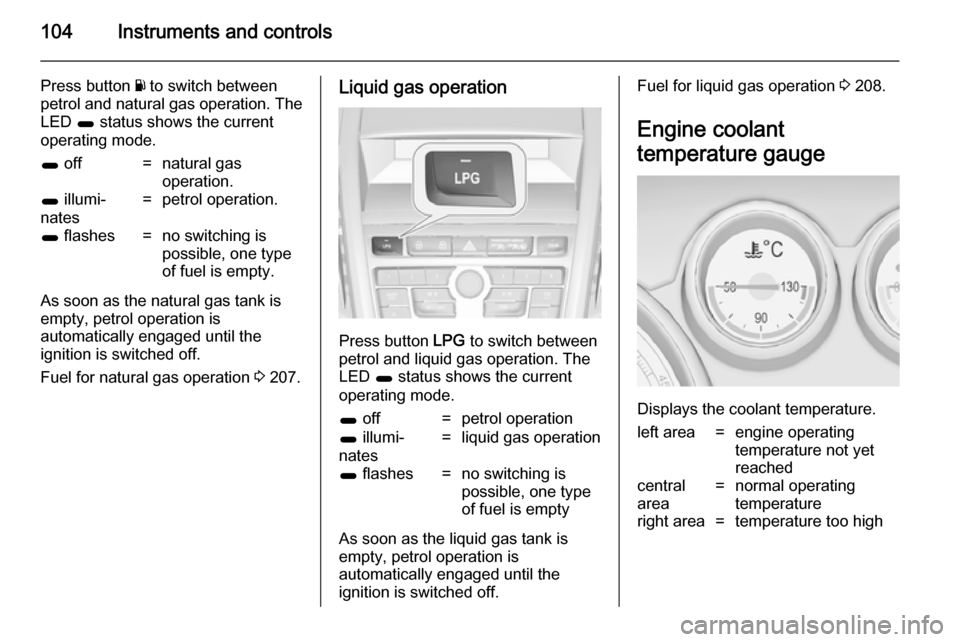
104Instruments and controls
Press button Y to switch between
petrol and natural gas operation. The LED 1 status shows the current
operating mode.1 off=natural gas
operation.1 illumi‐
nates=petrol operation.1 flashes=no switching is
possible, one type
of fuel is empty.
As soon as the natural gas tank is empty, petrol operation is
automatically engaged until the
ignition is switched off.
Fuel for natural gas operation 3 207.
Liquid gas operation
Press button LPG to switch between
petrol and liquid gas operation. The
LED 1 status shows the current
operating mode.
1 off=petrol operation1 illumi‐
nates=liquid gas operation1 flashes=no switching is
possible, one type
of fuel is empty
As soon as the liquid gas tank is
empty, petrol operation is
automatically engaged until the
ignition is switched off.
Fuel for liquid gas operation 3 208.
Engine coolant
temperature gauge
Displays the coolant temperature.
left area=engine operating
temperature not yet
reachedcentral
area=normal operating
temperatureright area=temperature too high
Page 210 of 297
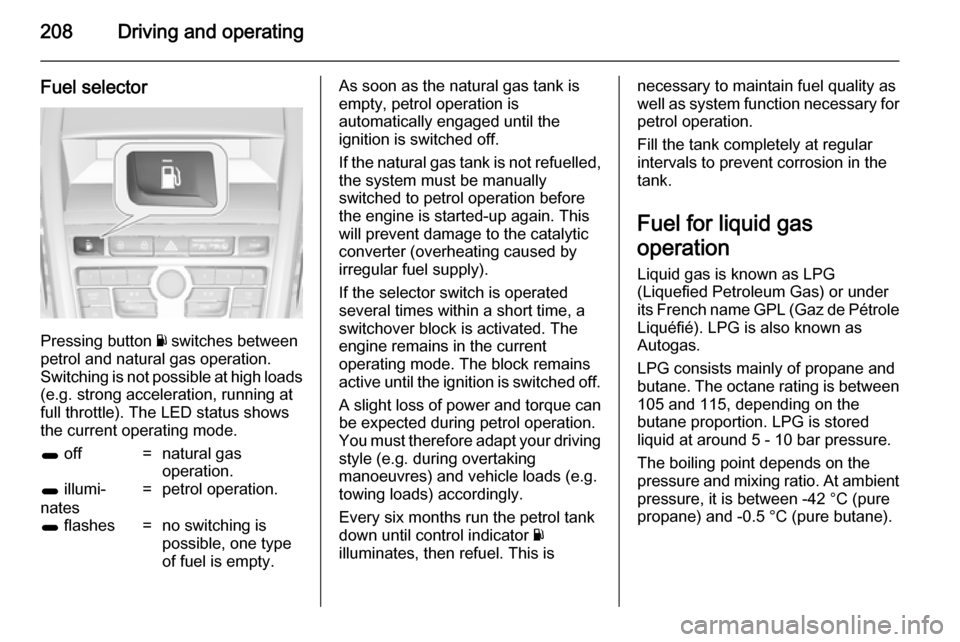
208Driving and operating
Fuel selector
Pressing button Y switches between
petrol and natural gas operation.
Switching is not possible at high loads
(e.g. strong acceleration, running at
full throttle). The LED status shows
the current operating mode.
1 off=natural gas
operation.1 illumi‐
nates=petrol operation.1 flashes=no switching is
possible, one type
of fuel is empty.As soon as the natural gas tank is
empty, petrol operation is
automatically engaged until the
ignition is switched off.
If the natural gas tank is not refuelled, the system must be manually
switched to petrol operation before
the engine is started-up again. This
will prevent damage to the catalytic
converter (overheating caused by
irregular fuel supply).
If the selector switch is operated
several times within a short time, a
switchover block is activated. The engine remains in the current
operating mode. The block remains
active until the ignition is switched off.
A slight loss of power and torque can be expected during petrol operation.
You must therefore adapt your driving
style (e.g. during overtaking
manoeuvres) and vehicle loads (e.g.
towing loads) accordingly.
Every six months run the petrol tank
down until control indicator Y
illuminates, then refuel. This isnecessary to maintain fuel quality as
well as system function necessary for
petrol operation.
Fill the tank completely at regular intervals to prevent corrosion in the
tank.
Fuel for liquid gas
operation Liquid gas is known as LPG
(Liquefied Petroleum Gas) or under its French name GPL (Gaz de Pétrole Liquéfié). LPG is also known as
Autogas.
LPG consists mainly of propane and
butane. The octane rating is between
105 and 115, depending on the
butane proportion. LPG is stored
liquid at around 5 - 10 bar pressure.
The boiling point depends on the
pressure and mixing ratio. At ambient pressure, it is between -42 °C (pure
propane) and -0.5 °C (pure butane).
Page 211 of 297
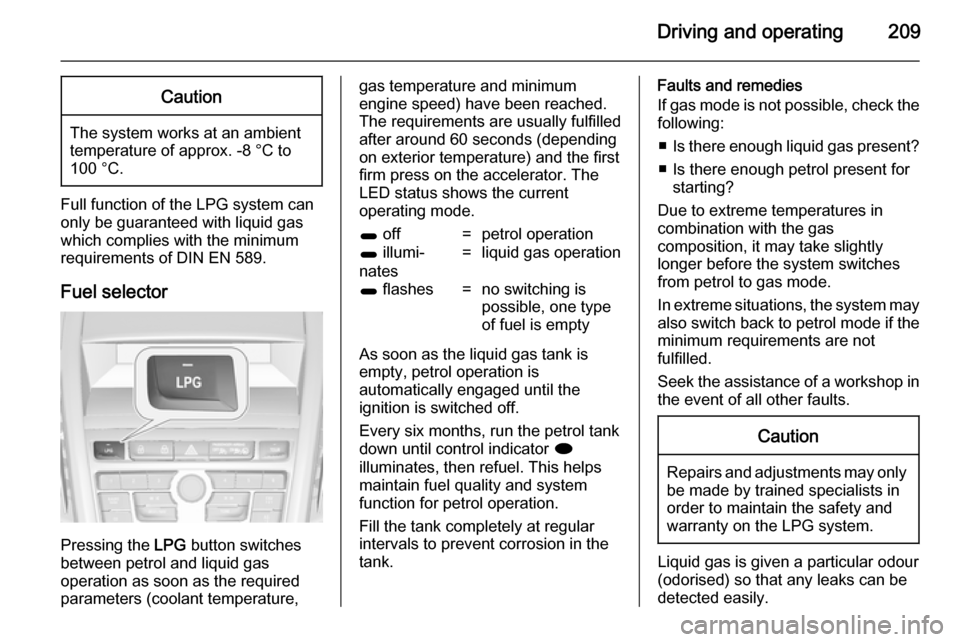
Driving and operating209Caution
The system works at an ambient
temperature of approx. -8 °C to
100 °C.
Full function of the LPG system can only be guaranteed with liquid gas
which complies with the minimum
requirements of DIN EN 589.
Fuel selector
Pressing the LPG button switches
between petrol and liquid gas
operation as soon as the required
parameters (coolant temperature,
gas temperature and minimum
engine speed) have been reached.
The requirements are usually fulfilled
after around 60 seconds (depending
on exterior temperature) and the first
firm press on the accelerator. The
LED status shows the current
operating mode.1 off=petrol operation1 illumi‐
nates=liquid gas operation1 flashes=no switching is
possible, one type
of fuel is empty
As soon as the liquid gas tank is
empty, petrol operation is
automatically engaged until the
ignition is switched off.
Every six months, run the petrol tank
down until control indicator i
illuminates, then refuel. This helps
maintain fuel quality and system
function for petrol operation.
Fill the tank completely at regular
intervals to prevent corrosion in the
tank.
Faults and remedies
If gas mode is not possible, check the following:
■ Is there enough liquid gas present?
■ Is there enough petrol present for starting?
Due to extreme temperatures in
combination with the gas
composition, it may take slightly
longer before the system switches
from petrol to gas mode.
In extreme situations, the system may
also switch back to petrol mode if the
minimum requirements are not
fulfilled.
Seek the assistance of a workshop in the event of all other faults.Caution
Repairs and adjustments may onlybe made by trained specialists in
order to maintain the safety and
warranty on the LPG system.
Liquid gas is given a particular odour
(odorised) so that any leaks can be
detected easily.
Page 214 of 297
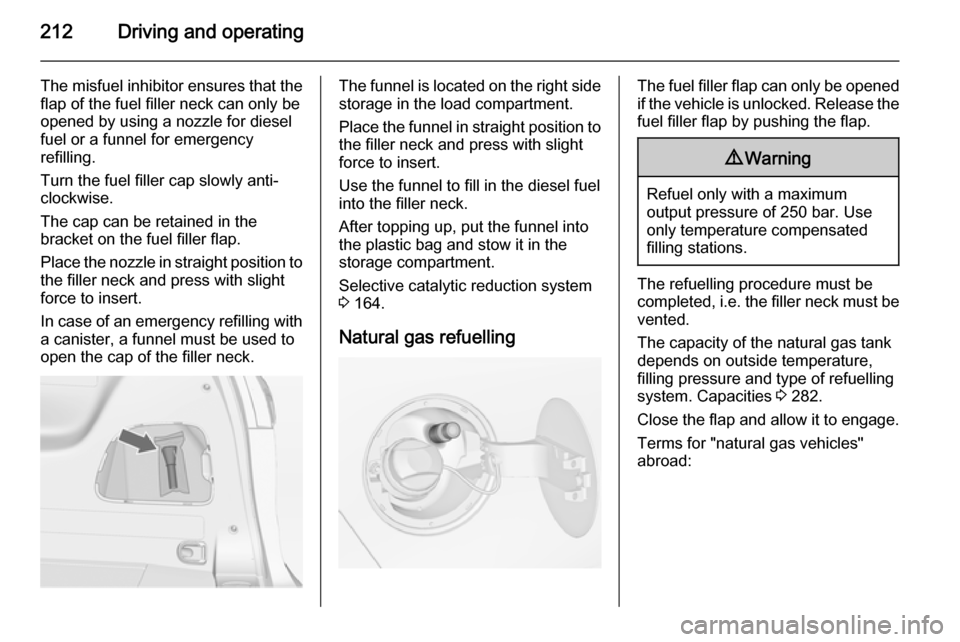
212Driving and operating
The misfuel inhibitor ensures that theflap of the fuel filler neck can only be
opened by using a nozzle for diesel
fuel or a funnel for emergency
refilling.
Turn the fuel filler cap slowly anti-
clockwise.
The cap can be retained in the
bracket on the fuel filler flap.
Place the nozzle in straight position to
the filler neck and press with slight
force to insert.
In case of an emergency refilling with a canister, a funnel must be used to
open the cap of the filler neck.The funnel is located on the right side storage in the load compartment.
Place the funnel in straight position to
the filler neck and press with slight
force to insert.
Use the funnel to fill in the diesel fuel
into the filler neck.
After topping up, put the funnel into
the plastic bag and stow it in the
storage compartment.
Selective catalytic reduction system
3 164.
Natural gas refuellingThe fuel filler flap can only be opened
if the vehicle is unlocked. Release the
fuel filler flap by pushing the flap.9 Warning
Refuel only with a maximum
output pressure of 250 bar. Use
only temperature compensated
filling stations.
The refuelling procedure must be
completed, i.e. the filler neck must be
vented.
The capacity of the natural gas tank depends on outside temperature,
filling pressure and type of refuelling
system. Capacities 3 282.
Close the flap and allow it to engage. Terms for "natural gas vehicles"
abroad:
Page 223 of 297
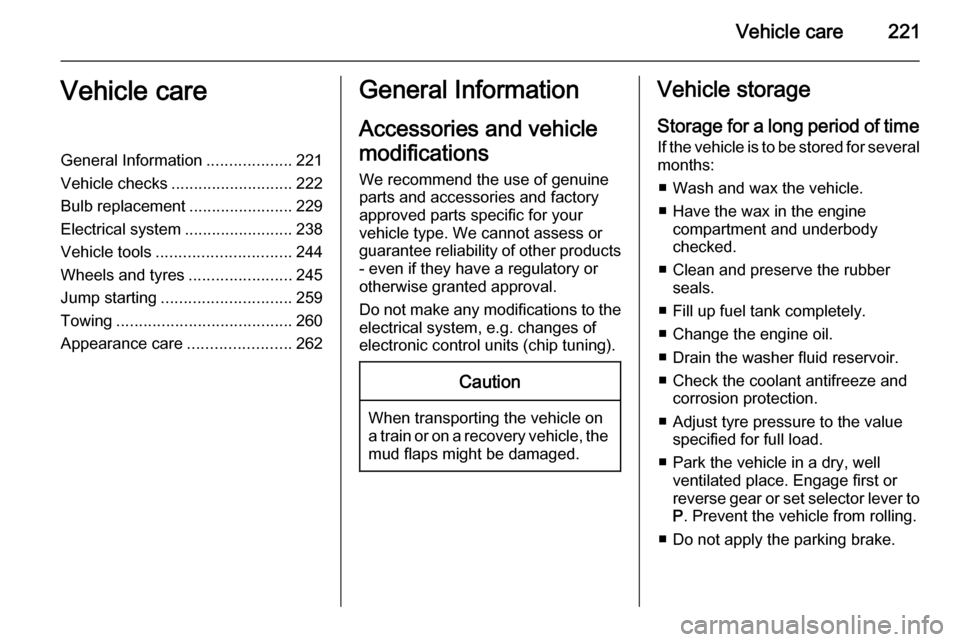
Vehicle care221Vehicle careGeneral Information...................221
Vehicle checks ........................... 222
Bulb replacement .......................229
Electrical system ........................238
Vehicle tools .............................. 244
Wheels and tyres .......................245
Jump starting ............................. 259
Towing ....................................... 260
Appearance care .......................262General Information
Accessories and vehicle
modifications
We recommend the use of genuine parts and accessories and factory
approved parts specific for your
vehicle type. We cannot assess or
guarantee reliability of other products
- even if they have a regulatory or
otherwise granted approval.
Do not make any modifications to the electrical system, e.g. changes of
electronic control units (chip tuning).Caution
When transporting the vehicle on
a train or on a recovery vehicle, the
mud flaps might be damaged.
Vehicle storage
Storage for a long period of time
If the vehicle is to be stored for several months:
■ Wash and wax the vehicle.
■ Have the wax in the engine compartment and underbody
checked.
■ Clean and preserve the rubber seals.
■ Fill up fuel tank completely.
■ Change the engine oil.
■ Drain the washer fluid reservoir.
■ Check the coolant antifreeze and corrosion protection.
■ Adjust tyre pressure to the value specified for full load.
■ Park the vehicle in a dry, well ventilated place. Engage first orreverse gear or set selector lever to P . Prevent the vehicle from rolling.
■ Do not apply the parking brake.
Page 247 of 297
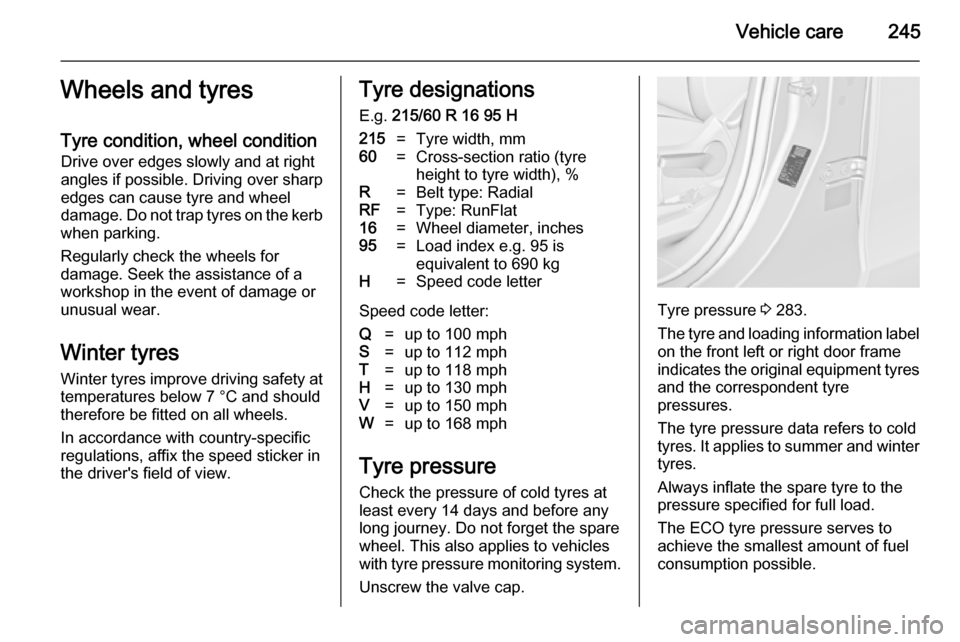
Vehicle care245Wheels and tyresTyre condition, wheel condition
Drive over edges slowly and at right
angles if possible. Driving over sharp
edges can cause tyre and wheel
damage. Do not trap tyres on the kerb
when parking.
Regularly check the wheels for
damage. Seek the assistance of a
workshop in the event of damage or
unusual wear.
Winter tyres Winter tyres improve driving safety attemperatures below 7 °C and should
therefore be fitted on all wheels.
In accordance with country-specific
regulations, affix the speed sticker in
the driver's field of view.Tyre designations
E.g. 215/60 R 16 95 H215=Tyre width, mm60=Cross-section ratio (tyre
height to tyre width), %R=Belt type: RadialRF=Type: RunFlat16=Wheel diameter, inches95=Load index e.g. 95 is
equivalent to 690 kgH=Speed code letter
Speed code letter:
Q=up to 100 mphS=up to 112 mphT=up to 118 mphH=up to 130 mphV=up to 150 mphW=up to 168 mph
Tyre pressure
Check the pressure of cold tyres at
least every 14 days and before any
long journey. Do not forget the spare
wheel. This also applies to vehicles
with tyre pressure monitoring system.
Unscrew the valve cap.
Tyre pressure 3 283.
The tyre and loading information label on the front left or right door frame
indicates the original equipment tyres
and the correspondent tyre
pressures.
The tyre pressure data refers to cold
tyres. It applies to summer and winter tyres.
Always inflate the spare tyre to the
pressure specified for full load.
The ECO tyre pressure serves to
achieve the smallest amount of fuel
consumption possible.
Page 276 of 297
![VAUXHALL ZAFIRA TOURER 2014 Owners Manual 274Technical dataEngine dataSales designation1.41.41.4 LPG1.6 CNGEngine identifier codeA14NELA14NETA14NETA16XNTNumber of cylinders4444Piston displacement [cm3
]1364136413641598Engine power [kW]8810310 VAUXHALL ZAFIRA TOURER 2014 Owners Manual 274Technical dataEngine dataSales designation1.41.41.4 LPG1.6 CNGEngine identifier codeA14NELA14NETA14NETA16XNTNumber of cylinders4444Piston displacement [cm3
]1364136413641598Engine power [kW]8810310](/img/38/19616/w960_19616-275.png)
274Technical dataEngine dataSales designation1.41.41.4 LPG1.6 CNGEngine identifier codeA14NELA14NETA14NETA16XNTNumber of cylinders4444Piston displacement [cm3
]1364136413641598Engine power [kW]88103103110at rpm4200-60004900-60004900-60005000Torque [Nm]200200200210at rpm1850-42001850-49001850-49002300-5000Fuel typePetrolPetrolLiquid gas/PetrolNatural gas/PetrolOctane rating RONrecommended95959595possible98989898possible91919191Gas––LPGCNGOil consumption [l/1000 km]0.60.60.60.6
Page 277 of 297
![VAUXHALL ZAFIRA TOURER 2014 Owners Manual Technical data275
Sales designation1.61.81.8Engine identifier codeA16XHTA18XELA18XERNumber of cylinders444Piston displacement [cm3
]159817961796Engine power [kW]12585103at rpm600056006300Torque [Nm]26 VAUXHALL ZAFIRA TOURER 2014 Owners Manual Technical data275
Sales designation1.61.81.8Engine identifier codeA16XHTA18XELA18XERNumber of cylinders444Piston displacement [cm3
]159817961796Engine power [kW]12585103at rpm600056006300Torque [Nm]26](/img/38/19616/w960_19616-276.png)
Technical data275
Sales designation1.61.81.8Engine identifier codeA16XHTA18XELA18XERNumber of cylinders444Piston displacement [cm3
]159817961796Engine power [kW]12585103at rpm600056006300Torque [Nm]260175175at rpm1650-320038003800Fuel typePetrolPetrolPetrolOctane rating RONrecommended989595possible959898possible919191Gas–––Oil consumption [l/1000 km]0.60.60.6
Page 278 of 297
![VAUXHALL ZAFIRA TOURER 2014 Owners Manual 276Technical data
Sales designation1.6 Turbo2.0 Turbo2.0 Turbo2.0 Turbo2.0 BiTurboEngine identifier codeB16DTHA20DTLA20DTA20DTHA20DTRNumber of cylinders44444Piston displacement [cm3
]15981956195619561 VAUXHALL ZAFIRA TOURER 2014 Owners Manual 276Technical data
Sales designation1.6 Turbo2.0 Turbo2.0 Turbo2.0 Turbo2.0 BiTurboEngine identifier codeB16DTHA20DTLA20DTA20DTHA20DTRNumber of cylinders44444Piston displacement [cm3
]15981956195619561](/img/38/19616/w960_19616-277.png)
276Technical data
Sales designation1.6 Turbo2.0 Turbo2.0 Turbo2.0 Turbo2.0 BiTurboEngine identifier codeB16DTHA20DTLA20DTA20DTHA20DTRNumber of cylinders44444Piston displacement [cm3
]15981956195619561956Engine power [kW]998196121143at rpm35004000400040004000Torque [Nm]320260300350400at rpm2000-22501750-25001750-25001750-25001750-2500Fuel typeDieselDieselDieselDieselDieselOil consumption [l/1000 km]0.60.60.60.60.6